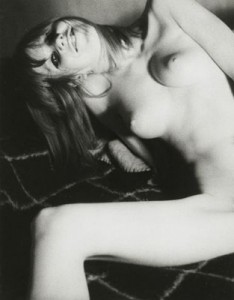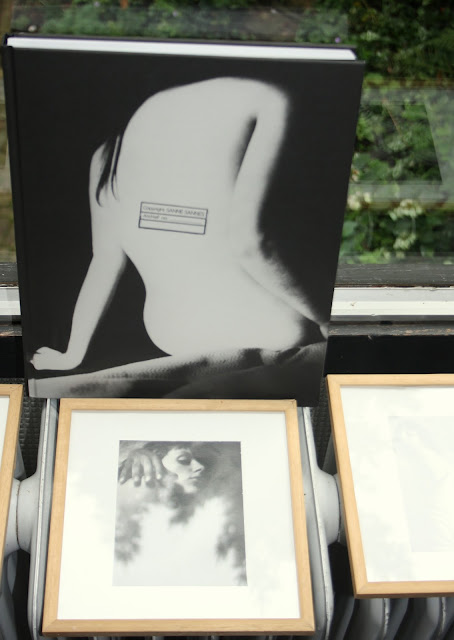To open the new cultural season, Kahmann Gallery presents an exclusive presen tation of vintage and unique works by the legendary Dutch photographer Sanne Sannes (1937-1967) in the exhibition Sanne Sannes – The Enduring Legend. The opening of the exhibition will take place on Saturday the 19th of September, during Unseen Photo Fair Amsterdam and will be part of the official programme of the fair.
Sannes remains one of the most captivating photographers of the 1960’s, having produced an outstanding body of work in the mere eight years he worked as a photographer, until his untimely death at the age of 30. His oeuvre is mostly built up of countless photographs of female nudes. Women were his favourite subject and an endless source of inspiration. In a nearly obsessive way, he photographed them during ecstatic sessions, often in the nude, recording their most intimate moments. This intimacy was emphasized in out of focus and underexposed photos; Sannes always worked with existing light and a hand-held camera. He wasn’t afraid to experiment with his work; he used close-ups, crops, scratched and painted on his negatives, exposed prints multiple times, the list goes on and on. Sannes felt no qualms about using these ‘wrong’ methods or techniques while making his images. He received no formal education as a photographer, he was trained as a graphic artist and painter. He was free from the formal and technical restraints that imposed other photographers and he didn’t feel the need to be precious about the process of making a photograph. In the end, it was the emotion and atmosphere that Sannes wanted to show with his work that was the most important to him.
During his lifetime, Sannes’ work did not remain unnoticed by the art world. His work was exhibited at the Groninger Museum, the Stedelijk Museum in Amsterdam and even the prestigious George Eastman House in Rochester, New York, featured his work in a group exhibition in 1963. Publishers also noticed Sannes’ intense images; in 1964 his work was published alongside the poetry of famed Belgian writer Hugo Claus (1929-2008) in the book Oog om Oog (Eye for an Eye). Sannes also worked as a commercial photographer, though he dreaded the fact that he couldn’t live of his art. It was on the way back from commercial assignment that Sannes crashed his car against a tree. He was killed instantly, his passengers, which included his assistant Gerrit Jan Wolffensperger, were badly injured.
After his death, Sannes’ work fell into obscurity for a number of years, but the last couple of decades has seen a renewed appreciation for the boundary-pushing nature of his photographs. His works has been featured in both solo and group exhibitions in museums and galleries all around the world, including the Rijksmuseum Amsterdam, Foam Amsterdam and the Institut Néerlandais Paris. Sannes’ work has been included in many national and international collections, both private and museum, including the Rijksmuseum, Stedelijk Museum and the Nederlands Fotomuseum Rotterdam.
The new monography with the work of Sanne Sannes, Copyright/Archief, published by Hannibal, in collaboration with the Rijksmuseum, will be available at Kahmann Gallery.
See for more Sanne Sannes :
New York: Mid-Century Vintage photographs by Dutch artists at Keith de Lellis Gallery Photography http://bintphotobooks.blogspot.nl/2015/03/new-york-mid-century-vintage.html
So you'd like to... 120 of the most significant Dutch photobooks the List Photography http://bintphotobooks.blogspot.nl/2012/03/so-youd-like-to-120-of-most-significant.html
OOG OM OOG (ŒIL POUR ŒIL) – Sanne SANNES (1964) in Bruno Mouron's 10 photoBooks Photography http://bintphotobooks.blogspot.nl/2011/06/oog-om-oog-il-pour-il-sanne-sannes-1964.html
Faces of Love Sanne Sannes Photography http://bintphotobooks.blogspot.nl/2010/08/faces-of-love-sanne-sannes-photography.html
Top 40 Photographs Dutch Photography Nieuwe Revu http://bintphotobooks.blogspot.nl/2010/06/top-40-photographs-dutch-photography.html
Erotic Photography Sanne Sannes versus Wingate Paine Photography Annual 1967 International Edition http://bintphotobooks.blogspot.nl/2009/11/erotic-photography-sanne-sannes-versus.html
The Making of a Photobook: Sanne Sannes’ Maquette for Diary of an Erotomaniac Photography http://bintphotobooks.blogspot.nl/2009/10/making-of-photobook-sanne-sannes.html
Dummy Photobook 'Dagboek van een erotomaan' [Diary of a Erotomaniac] Sanne Sannes Photography http://bintphotobooks.blogspot.nl/2009/10/dummy-photobook-dagboek-van-een.html
Sanne Sannes the Vintage Works Hup Gallery Photography http://bintphotobooks.blogspot.nl/2008/09/sanne-sannes-vintage-works-hup-gallery.html
Dutch Books of Nudes Alessandro Bertolotti Sanne Sannes Anthon Beeke Ed van der Elsken Ginger Gordon Diana Blok Graphic Design Typography Photography http://bintphotobooks.blogspot.nl/2008/07/dutch-books-of-nudes-alessandro.html
Drukkersweekblad / Autolijn Grafisch Nederland 1963 Foto Grafie Photography http://bintphotobooks.blogspot.nl/2008/02/drukkersweekblad-autolijn-grafisch.html
After seeing a book of photos, Frodo Terpstra became captivated by the life and work of photographer Sanne Sannes, who died in a car accident in 1967 at the age of 30. Who was this man who took experimental, grainy erotic pictures of women? Sannes's photos suggest a degree of intimacy between the models and their photographer. Was he a playboy, some kind of James Dean of photography? To find answers to these and other questions, Terpstra visits relatives, old friends, models and possible loves from Sannes's past. Sannes's brother Rob owns his complete photo archive, but he isn't very communicative about Sannes. He can't seem to answer the question of who his brother actually was. Sannes's college friend Martin didn't know him very well, either. He was more closed than a cocoon." In the voice-over, Terpstra wonders if the pictures tell us something about his inner life, and if the myth of the sex maniac is really appropriate. In between the interviews, we see black-and-white images of Sannes's work and Terpstra divulges his findings and philosophies about who Sannes was and what the key to his work might be. The film is a result of the IDFA scenario workshop, which Terpstra won in 2004.
 Sanne Sannes moet een van de eerste levende kunstenaars zijn geweest door wie ik gegrepen werd. Al wist ik aanvankelijk waarschijnlijk niet dat hij kunstenaar was. Sanne Sannes was een fotograaf wiens foto’s soms in tijdschriften stonden, en dankzij die foto’s ging ik een wereld binnen, waar ook de muziek van The Rolling Stones opklonk en de romans van Sartre werden gelezen.
Sanne Sannes moet een van de eerste levende kunstenaars zijn geweest door wie ik gegrepen werd. Al wist ik aanvankelijk waarschijnlijk niet dat hij kunstenaar was. Sanne Sannes was een fotograaf wiens foto’s soms in tijdschriften stonden, en dankzij die foto’s ging ik een wereld binnen, waar ook de muziek van The Rolling Stones opklonk en de romans van Sartre werden gelezen.Een bevrijde wereld. Het waren de jaren zestig en hier en daar verschenen ineens afbeeldingen van uitdagende, of zelfs klaarkomende vrouwen, die in niets leken op de keurige naakten die ik kende uit de Knaur’s Lexikon der Moderne Kunst van mijn vader. Terwijl Aat Veldhoen bij de firma Gort aan de Prinsengracht zijn rotaprenten verkocht, maakte Sanne Sannes in het Noord-Hollandse bos foto’s van vrouwen, nee meisjes die met heel hun ziel en zaligheid op leken te gaan in iets wat ‘seks’ moest zijn, maar waarvan ik zelf toen nog niet zo goed wist hoe het eigenlijk werkte.
Sindsdien heb ik op dat gebied het nodige bijgeleerd, en ik was dan ook bang om de foto’s van Sanne Sannes terug te zien. Zoveel jaar na dato kun je maar beter niet opnieuw je jeugdliefde gaan opzoeken. Ontmaagdingen kun je nu eenmaal niet overdoen.
Maar wel bij Sanne Sannes, kennelijk. Het gekke is dat ik hem nog steeds goed vind, nu misschien nog wel meer dan toen.
Ik denk dat deze duurzame waardering voor een belangrijk deel komt door de vorm van contact die Sannes met zijn modellen wist te maken. Over zijn werkwijze doen verschillende verhalen de ronde, die er meestal op neerkomen dat hij seksueel eigenlijk maar weinig voorstelde. Maar wat je aan zijn werk kunt zien is dat hij juist daarom heel goed kon kijken. Hij was nauwelijks met lenzen, licht of techniek bezig, maar hij keek voorzichtig uit de schaduw naar zijn meisjes en drukte dan af.
Op een van zijn foto’s die nu in Foam te zien zijn, zie je Sanne zelf – vraag me niet hoe – een verlegen, ernstig kijkende man met een rolleiflex. Hij probeert niemand te imponeren, zet zijn modellen niet gewiekst naar zijn hand, maar is misschien eerder nog bang voor ze. Wat de meisjes daardoor gaan doen is hem op zijn gemak proberen te stellen. Kijk maar, zeggen ze, we doen je niets, maar we vinden het wel leuk om stiekem bekeken te worden.
De tentoonstelling in het Foam laat zien dat Sanne Sannes samen met Johan van der Keuken en Eva Besnyö nog altijd tot de beste ‘available light’ fotografen van na de oorlog behoort. Hij deed in de paar jaar dat hij leefde niets om zijn modellen te manipuleren, maar gebruikte integendeel zijn rollei – wanhopig?- om op een basaal niveau met anderen in contact te komen, nadat hij ze eerst hun beschermende pantsers had laten afleggen. Hij geeft ons daardoor nog steeds het idee dat wij het zelf zijn, die dit contact met ze maken. En dat doet ons – kennelijk- goed.
Deze tekst verscheen ook als ‘Kunstwerk van de dag’ op de site www.galeries.nl . Vanaf vandaag schrijft Reinjan Mulder tot 1 december dagelijks een bijdrage voor deze beeldende kunst-site.











































